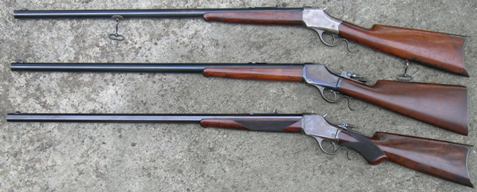September 19, 2014
 Offline
OfflineFolks,
Another thought came to mind as I punched the button to send the last post, and that can be dangerous. I am often guilty of assigning today’s practices to those of yesterday at Winchester (and by no means do I really understand production and sales today!) At one point in time, Winchester truly valued their employees as the skilled craftsmen they were. Could it have been possible that Winchester continued to make rifles in some varying configurations without having orders standing for those configurations, in order to keep their craftsmen employed and skills current? Was it all that much a “sin” in a business sense in those days to have 5 or 6 year old stock in the warehouse? Today it seems the idea is to only have a day or two raw materials on hand, and to warehouse but a few days worth of product to ship out, relying on computers and mechanization to have the correct and only the correct quantity of material or product on hand at the moment. It was a different world in the late 1800’s and early 1900’s. Do we have anyone extant that has a better grasp of history in this regard than I do, who could elucidate on this matter?
Thank you for kind consideration of the above brain storm!
Tim
December 31, 2012
 Offline
OfflineIn 1912 when this rifle was shipped, the popularity of the caliber was waning. Up till the very early 30’s Winchester only kept small orders of steel to make rifles with. That all changed when Mr. Olin bought the company and discontinued all the specialty steel and had the employees order bigger lots of steel. No more stainless steel bbls. or nickel steel bbls were made expressly for the M52. That’s why both are so rare today. We will never know why my rifle sat for 5 1/2 years in the whse., but I do know, as to the condition of this rifle, it wasn’t used much after that. I paid high end for the rifle and have never regretted it. Thanks, Big Larry
April 15, 2005
 Offline
OfflineTim, et al,
Yes, Winchester did indeed manufacture thousands of “catalog” rifles & carbines without having a specific order for them in advance. The ledger records show batches of calibers, configurations, and types (variations) throughout the production. The guns were built and sent to the warehouse, and then sold as orders were received.
Bert
WACA Historian & Board of Director Member #6571L

November 7, 2015
 Offline
OfflineI agree on many points, Tim. Today’s mfr’s can’t see much past the next quarterly report and inventory over 90 days old is a serious problem. A lot of exciting changes were made in the late 19th century but a gun built in the early 1900’s would have been current for several years. The mindset that allowed that rifle to be produced and sent to the warehouse to sit for a few years would be disastrous today, my goodness how times have changed!
1 Guest(s)


 Log In
Log In




